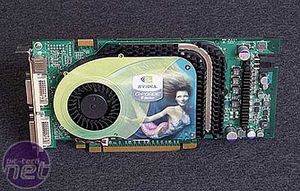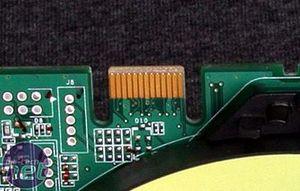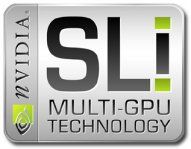
Back in the early 1990's we saw the first emergence of parallel graphics processing, which were used only in super computers. Quite frankly the cost of the technology back in those days was more than 99.9% of us could afford. Even if you could afford to spend $250,000 minimum on a system to run these early video cards, you had to have the space to house the supercomputer that these cards were housed in - certainly not for the feint-hearted! Getting closer to where we're at today; 1998 saw the introduction of 3dfx's implementation of parallel graphics processing with their dual Voodoo 2 SLI technology - this allowed the end user to be able to play the game of the era back then, Quake 2 at 1024x768 at a playable frame rate.
Since then, the death of PCI graphics came about due to the sheer lack of bandwidth in the PCI bus, along with the introduction of the AGP interface that has provided a sturdy interface for graphics solutions over the past 5 or 6 years. With increasing bandwidth requirements for the last round of graphics card releases, it was soon realised that AGP could not go on forever. This lead to the introduction of PCI-Express which, in turn, has given manufacturers the opportunity to re-introduce multi-graphics card possibilities. Yesterday, NVIDIA raised the curtain on their interpretation of SLI technology - SLI standing for Scalable Link Interface, which makes the use of dual PCI-Express graphics cards a reality.
In the quest for smoothness over the past few years, we've seen Hyper-Threading technology come about, along with the more recent introduction of Native Command Queuing (NCQ) into Intel's ICH6 Southbridge, which allows hard drives to reorder dynamically its requests according to the location of the requests on a platter. This accompanied with Intel's Matrix Raid provides a very promising development in storage solutions. If you thought that graphics technology was being ignored; we've now essentially got parallel graphics processing abilities with NVIDIA's SLI technology. At the same time, we've seen that Alienware have been working on their own parallel graphics processing technology, which will be introduced in their ALX line of systems – this is known as Alienware's Video Array.
Firstly, let's take a look at what NVIDIA have come up with, and then we'll take a look at what Alienware have up their sleeves.
The NV45
Until now, we've not had a look at the NV45, or in fact any NVIDIA PCI-Express graphics solution; so here we have it, NVIDIA's PCI-Express version of the 6800 series graphics cards. At a glance, the card looks exactly the same as their AGP counterparts, apart from the obvious difference between the interface connector.

 On closer inspection of the NV45 PCI-Express graphics board, you can see that there's a rather strange looking slot-style connector on the top of the card. A first assumption that I made when I saw this was that it was an NVIDIA-specific diagnostic connector, which would allow NVIDIA to diagnose early versions of their PCI-Express graphics boards. It turns out that this is in fact the Scalable Link Interface connector that we're taking a look at here today.
On closer inspection of the NV45 PCI-Express graphics board, you can see that there's a rather strange looking slot-style connector on the top of the card. A first assumption that I made when I saw this was that it was an NVIDIA-specific diagnostic connector, which would allow NVIDIA to diagnose early versions of their PCI-Express graphics boards. It turns out that this is in fact the Scalable Link Interface connector that we're taking a look at here today.
 You also notice that there's a new molex connector on PCI-Express graphics boards - both the 6800 Ultra and the 6800 GT will come with the funky single molex connector (above) rather than the larger hard-drive style connector(s) of the AGP versions.
You also notice that there's a new molex connector on PCI-Express graphics boards - both the 6800 Ultra and the 6800 GT will come with the funky single molex connector (above) rather than the larger hard-drive style connector(s) of the AGP versions.
This new approach is much neater: it takes up less space on the board and should neaten up the mess of cables through the bundled Y-splitter adapter. The 6800 GT only requires one of these to be connected, while the 6800 Ultra will still require two separate power lines from the power supply to provide the extra juice it needs.
Since then, the death of PCI graphics came about due to the sheer lack of bandwidth in the PCI bus, along with the introduction of the AGP interface that has provided a sturdy interface for graphics solutions over the past 5 or 6 years. With increasing bandwidth requirements for the last round of graphics card releases, it was soon realised that AGP could not go on forever. This lead to the introduction of PCI-Express which, in turn, has given manufacturers the opportunity to re-introduce multi-graphics card possibilities. Yesterday, NVIDIA raised the curtain on their interpretation of SLI technology - SLI standing for Scalable Link Interface, which makes the use of dual PCI-Express graphics cards a reality.
In the quest for smoothness over the past few years, we've seen Hyper-Threading technology come about, along with the more recent introduction of Native Command Queuing (NCQ) into Intel's ICH6 Southbridge, which allows hard drives to reorder dynamically its requests according to the location of the requests on a platter. This accompanied with Intel's Matrix Raid provides a very promising development in storage solutions. If you thought that graphics technology was being ignored; we've now essentially got parallel graphics processing abilities with NVIDIA's SLI technology. At the same time, we've seen that Alienware have been working on their own parallel graphics processing technology, which will be introduced in their ALX line of systems – this is known as Alienware's Video Array.
Firstly, let's take a look at what NVIDIA have come up with, and then we'll take a look at what Alienware have up their sleeves.
The NV45
Until now, we've not had a look at the NV45, or in fact any NVIDIA PCI-Express graphics solution; so here we have it, NVIDIA's PCI-Express version of the 6800 series graphics cards. At a glance, the card looks exactly the same as their AGP counterparts, apart from the obvious difference between the interface connector.


This new approach is much neater: it takes up less space on the board and should neaten up the mess of cables through the bundled Y-splitter adapter. The 6800 GT only requires one of these to be connected, while the 6800 Ultra will still require two separate power lines from the power supply to provide the extra juice it needs.

MSI MPG Velox 100R Chassis Review
October 14 2021 | 15:04








Want to comment? Please log in.